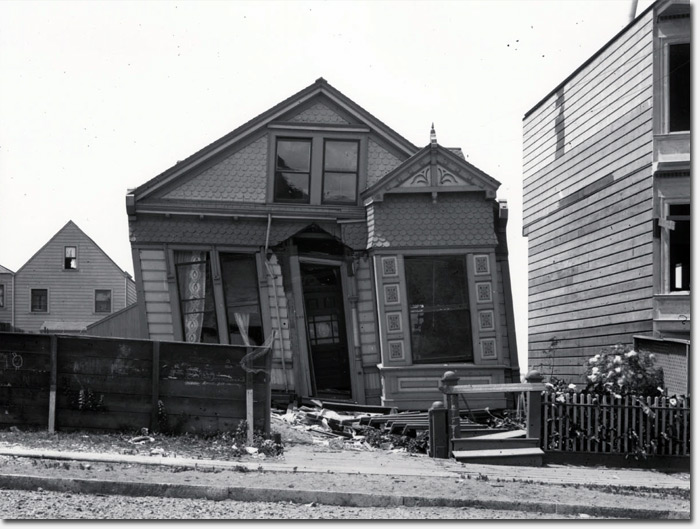
A crumbling house at 11th Avenue and California in 1906. Courtesy Bancroft Library
It was 108 years ago today at 5:12am when a massive earthquake struck San Francisco, killing an estimated 3,000 people and destroying nearly 80% of the city. Between 227,000 and 300,000 people were left homeless out of a population of about 410,000. [Wikipedia]
Here in the Richmond District, there was only a small population. People had just started moving to the “Outside Lands” in the 1880s, and much of the neighborhood was still covered in sand dunes.
The unpopulated landscape of the Richmond District proved to be ideal for refugee camps. Camp 25, dotted with hundreds of what would become known as “earthquake shacks”, spanned what is now Park Presidio Boulevard.
Golden Gate Park was the setting for many refugee camps where displaced residents lived in canvas tents. Many of the camps were still in existence long after the quake, with the final one closing in June 1908.
Every year on April 18th, San Francisco commemorates the 1906 earthquake with a ceremony at Lotta’s Fountain, located at the intersection of Market Street, where Geary and Kearny Streets connect. The cast iron fountain served as a meeting point during the earthquake and fire aftermath.
Another commemoration will take place at 20th and Church Streets at 5:40am when a hydrant, that was crucial to fighting the fires in 1906, is re-painted gold.
City celebrations are usually attended by remaining survivors from the 1906 quake, but there are only two left.
One of them, Bill de Monte, celebrated his 108th birthday in January. He won’t be at the ceremony this morning, but he did tape a video message that will be shown.
Sarah B.
Most of the photos in this post are from the Bancroft Library’s stellar online collection of photos of San Francisco post-earthquake. The site includes an interactive map that lets you explore the archives by neighborhood.
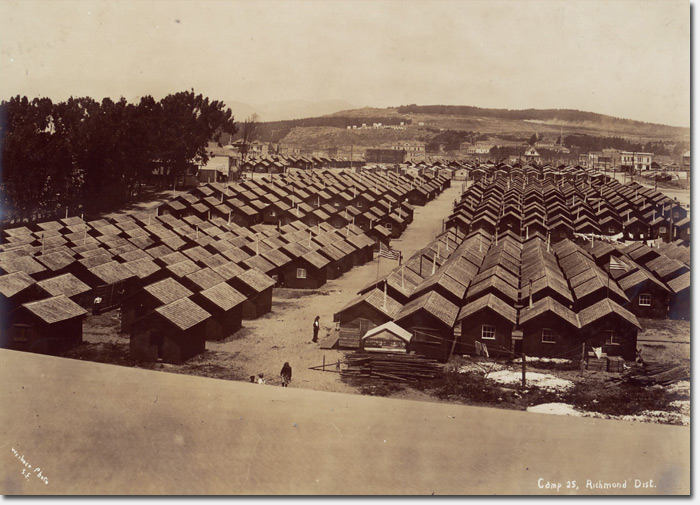
Camp 25 located along what is now Park Presidio Boulevard. Courtesy Bancroft Library.
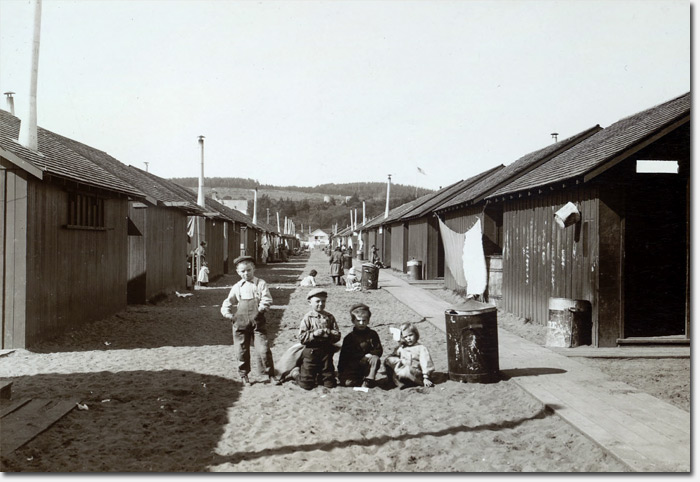
Kids in Camp 25, one year after the earthquake. 2,400 shacks still remained. Courtesy Bancroft Library.
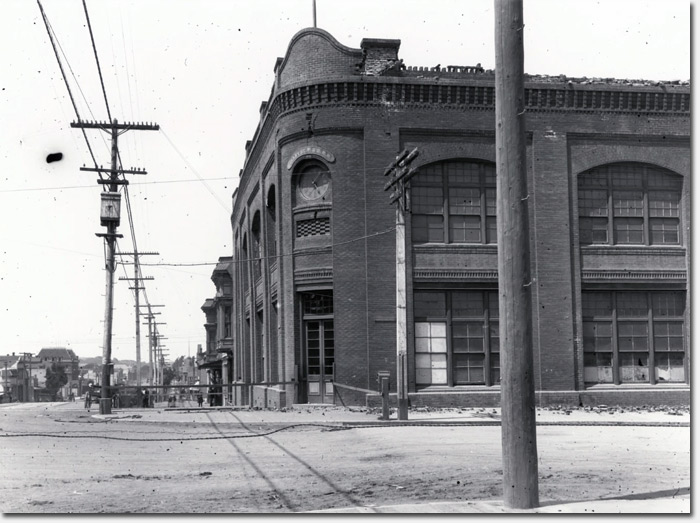
A crumbling depot building at Geary and Arguello. Today it is OfficeMax. Courtesy Bancroft Library.
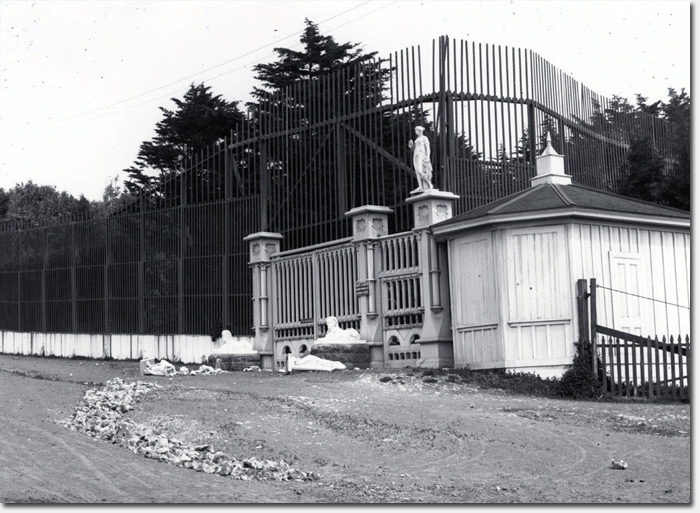
The north tower gate of Sutro Heights Park. Courtesy Bancroft Library.

The Martha Kip orphanage at 520 Lake near 7th Avenue. Courtesy Bancroft Library.
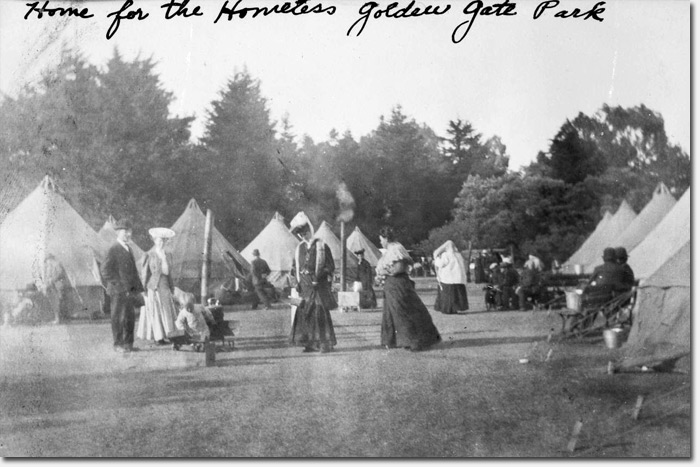
One of the refugee encampments in Golden Gate Park. Courtesy Bancroft Library.
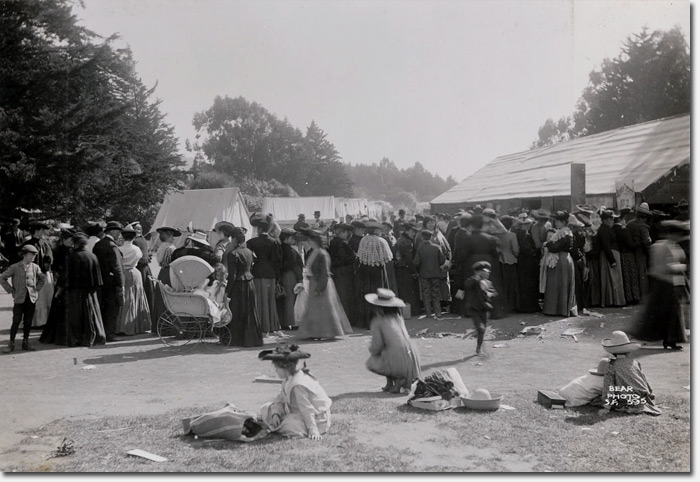
Refugees line up for food or supplies in a Golden Gate Park camp. Courtesy Bancroft Library.
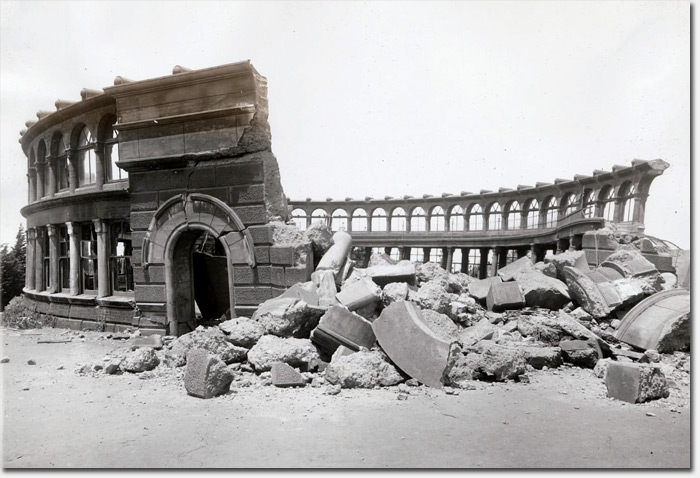
The Sweeny Observatory atop Strawberry Hill lay in ruins after the quake. Courtesy Bancroft Library.
Hopefully they’re repainting the Golden Hydrant gold and not silver…. :-S
Times have surely changed. In looking at the second-to-last photo (the refugees lining up for food), I can’t help but notice how well-dressed everyone is. Did these folks not own anything more casual than a suit or a billowy Edwardian dress? Or was it simply important back then to look well-heeled (even when homeless)?
20th and Church, not Market
Tim, When evacuating one took what was of most value, which meant wearing layers of clothing, especially if it was not possible to load in a cart that was already full. Most people did not have the expansive wardrobes we have today, perhaps two skirts and blouses, two dresses, and if needed, one formal/church dress. The prosperous had more than two pairs of shoes. Casual wear did not exist for women back then and most men (except laborers) wore suits.
Mamah (my grandmother) was expecting her first child when The Big One hit and they did time at a camp even though she could have gone to stay with either her sister or mother over in Oakland. My father was born a few years later at home, on the dining room table so as not to soil the bed. I never found out where my Papah’s (my grandfather) sister stayed then as I was more fascinated with hearing about her travels to China and other exotic locales in the 1920s when we dined at the Hippo in her neighborhood (Polk Gulch) in my childhood. Papah was pressed into long hours at work after the Big One as he had many ironworkers efforts to coordinate as a shop foreman.
The only times I ever saw my father without a jacket on was inside the house, on a golf course, or while doing heavy yard work. He even wore jackets for his kindergarten and elementary school class pictures at the original Argonne School. I never met Papah and all the men of his generation and the majority of my father’s generation were never seen in public without a jacket (and often a necktie) on. The women of that generation only wore trousers when skiing at Tahoe or when hiking in the Sierra.
Thanks for the memories, 4th Gen. I imagine just about all men wore hats, too.
To answer your question, Tim Bracken: People did own and wear more casual clothes. When evacuations were declared after the earthquake, evacuees could take only a limited amount of belongings with them. The more resourceful among them took their best clothes, as they were the most expensive to replace. Thus most of the post-earthquake photos of refugees that you see are wearing their “Sunday best” because they couldn’t save anything else.
The Richmond District was scarcely populated, and had very little damage in the 1906 earthquake because of the types of construction and subsurface buildings were built on. The fire that swept through the congested areas of downtown, inner-Mission, Hayes Valley, Russian Hill and North Beach was where the major destruction of the city occurred. I have found no evidence of fire in the Richmond. The soil in our neighborhood is primarily sand, generally second to rock in stability during a quake. The majority of housing at the time here were cottages to flats, not taller than three stories, all made of wood which can flex in a quake. The photo of the cottage on 11th Ave. shows a building on a slight grade that was probably on a simple brick foundation and had no internal diagonal bracing, all trouble factors to be accounted for in earthquake country.
The buildings that did suffer damage, as pictured, were of brick. The orphanage is misidentified as “Martha” but it was the Maria Kipp Orphanage that stood on the NE corner of 7th Ave. and Lake, that was repaired and in operation until the early 1920s, now with two large apartment buildings on that site. The original brick 1895 French Hospital also suffered facade damage. There was brick chimney damage in many buildings, because they protruded above the roof and had no bracing.
Earthquakes will happen again in our area. Each quake offers a living laboratory for architects and engineers to study how materials and construction techniques fared under the stress of shaking. We live in a neighborhood of a relatively stable subsurface, with the majority of buildings constructed after the lessons of 1906 were learned and applied. After the Loma Prieta quake of 1989, my house had only slight damage, but I was alerted to repair a back wall where a stairs had been and water had caused rotting to support studs. Maintenance is another crucial factor to earthquake safety.
Neat pictures. I really appreciated reading the comments to this nice posting. I love to hear the first-hand stories and analysis.